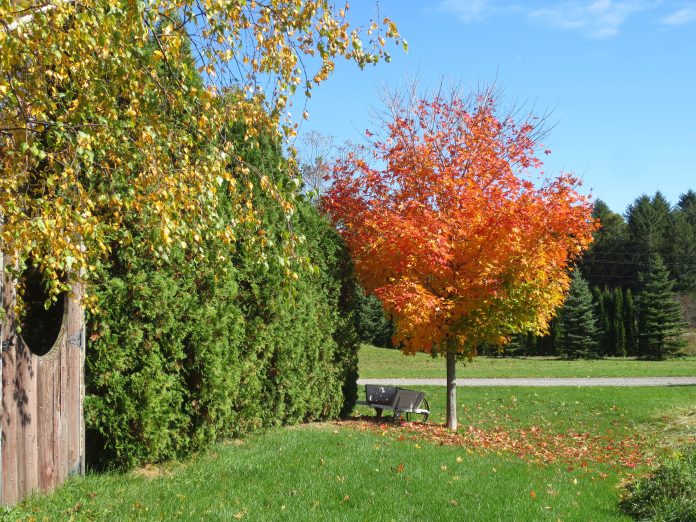
There are many activities that we can enjoy this time of year in the garden that will pay big dividends later in the season, next spring and even for years to come. Here are our top 5 tips to make the most of your fall garden:
- Colour. Ontario is world famous for fall colour. While nothing substitutes for a trip up north to see the changing leaves of Algonquin park, you have an opportunity to create a show in your own yard or balcony by planting trees and shrubs that show off each fall. A short list of the best, brightest stars in the leaf-colour category that you can plant now:
Native Canadian sumac, brilliant red, early in the season. Birds like the fruit too.
Canadian Larch, another native, only this one is “deciduous evergreen”. Has the look of an evergreen but drops its foliage late each fall, in mid November. A great farewell to a fine growing season. Very winter hardy. Grows to 15 metres.
Sugar Maple. The maple that produces maple sugar-sap come spring also produces the best fall show of colour of all maples. Sometimes red-orange, other times yellow. Always beautiful. Other deciduous (trees with leaves, vs. needles) that provide a great fall show include red and white oaks, which turn red this time of year. They derive their name from the colour of their wood. Little leaf lindens and native basswood, which are related, turn brilliant yellow. Beech trees, both European and native Canadians, turn yellow later in the season.
- Colour. Not leaf colour, but flowers that look fabulous in your garden now through hard frost. Our #1 pick are New England Asters, which are native here, not just in New England, and produce abundant blue or purple flowers each fall. Reliable perennials.
Chrysanthemums. There are so many “Mums” available for sale at retailers this time of year that it seems redundant to suggest that you plant a few. At the front door, in containers, in the garden outside the back door. Wherever you would like to see unstoppable colour. Not reliably winter hardy, but worth the investment just the same.
Flowering cabbage and kale are flowering plants that improve with frost. Imagine colour that peaks mid November! Not edible, though, we wish.
Rudbeckia. The yellow flowering “Black Eyed Susan” has been showing off since late August. They have more gas in their flower tank than any fall blooming plant we know.
- Start or thicken a lawn. This is the best time of year to spread grass seed to thicken an established lawn, start a new one or lay fresh sod. We highly recommend that you spread a couple of centimetres of triple mix or compost, broadcast quality grass seed, rake smooth and water. Stand back and watch the miracle happen. But hurry, this works best when done by the end of September. No need to fertilize until late October or November.
- Compost. The zucchini plants delivered their bounty some weeks ago and now they are dried up and the leaves yellow. Dig them up and toss in your compost bin or pile. Let them rot there. Same with finished annuals and other vegetable plants that have produced and are now in decline. The frost will break down any green, living tissue in the plant and they will become mostly water, with the remains providing nutrients for the compost and eventually for your garden, that is, when you spread the finished material on your garden next spring.
- Feed the birds. Many bird species are returning from their happy mating grounds in the Boreal Forest where they hatched a family and brooded their new young. Many are on their way south for the winter. As they prepare for that long trip, especially across Lake Ontario, they consume a lot of food to “beef up” for the trip. This is a great time of year to feed hungry birds including hummingbirds, which linger here until the first killing frost.
Fall is for gardening. Enjoy these shortcuts to the best fall garden ever, with added benefit next season.
Mark Cullen is an expert gardener, author, broadcaster, tree advocate and Member of the Order of Canada. His son Ben is a fourth-generation urban gardener and graduate of University of Guelph and Dalhousie University in Halifax. Follow them at markcullen.com, @markcullengardening, and on Facebook.

